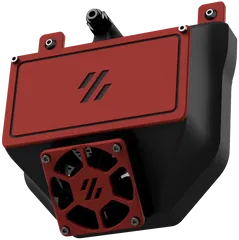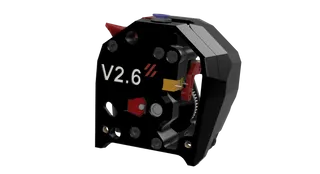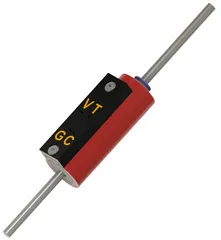Blobifier for Voron 2.4 350mm Printer
Description
PDFBuild Instructions:
- Print Blobifier and optionally Brush Holder and associated Bucket-Brush,
- Install M3x2 Magnet into Bucket-Miller350,
- Install 4 Heat Sets into SB_Shaker_arm,
- Install the SB_Shaker onto the SB_Shaker_arm using 2 M3x8 FHCS screws,
- Install the above assembly onto the Bucket-Miller350 using 2 M3x8 FHCS screws,
- Cut a 17.2 x 12.4mm PCB Board from a larger Prototype board. This will be used to mount the JST-XH connector. See BOM for recommended Prototype board. It is highly desirable that whatever board that the cut is made from has interconnected columns of plated through holds and such columns are at right angles to the JST-XH connector as well as the A3144 Hall Effect Transistor. This is to ensure that wires soldered to the PCB also connect to the JST-XH connector and A3144 Transistor,
- Cut an additional 14.35 x 9.75mm PCB for the Hall Effect Transistor. See above comments,
- Cut the servo Wiring to a 60mm length as measured from the servo body,
- Cut 3 wires (Red, Black, Blue) to a length of 60mm. These wires will be used to connect the A3144 board to the JST-XH PCB,

- Form the A3144 leads as follows. The larger flat surface of the transistor must face outward when soldered to the PCB:
- Carefully bend the outer two legs of the transistor outward at a 90-degree angle. This is necessary to afford leg separation for the 2.54mm PCB Hole Spacing,
- Now bend all three legs downward at a 90-degree angle,
- Insert the A3144 into its PCB as depicted in the picture above,
- Solder the A3144 and the 3ea 60mm wires to the A3144 PCB as indicated. The wires should be as follows from left to right as viewed from the transistor side:
- Blue - Signal (Ground = Installed)
- Black - Ground
- Red - 5Vdc


- Solder the other end of the A3144 wires to the bottom JST-XH PCB plated through holes (pictured above) from left to right as follows. Note: Pins are numbered with respect to the JST-XH connector. There may be unused holes either side of the connector pin columns:
- Black (Ground)
- Red - 5Vdc
- NC - Not Connected
- Blue - Bucket Installed Signal
- Solder the 3 servo wires to the JST-XH PCB next higher row left to right as follows:
- Black (or Brown) - Ground
- Red - 5Vdc
- Orange - Signal
- Solder the JST-XH connector to its PCB. Note the connector orientation in the photo above. The connector is mounted on the opposite side from the wires that were previously soldered to the PCB,
- Install the servo into the Base_Miller350 from the top of the part. Carefully route the wiring harness to insure it is not damaged. The mount for the servo is purposely tight fit but it should slide in without any modification,
- Secure the Servo using two M2x6 SHCS Screws or equivalent,

- Install the two PCBs in their respective slots. The PCBs should be flush with the bottom of the base if properly installed,
- Construct a wiring harness long enough to reach the controlling MCU. Using a JST-XH female connector oriented with the locator strips up and viewed from the cable end, wire the connector from left to right as follows:
- Black - Common Ground
- Red - Common 5Vdc
- Orange - Servo Signal to Servo
- Blue - Signal from A3144
- Terminate the opposite end of the cable as required by the MCU. Note: The wire order differs from the one in the original Blobifier Design. Due to space limitation the wire order follows the servo wire order to avoid wire crossover in tight spaces:
- Servo Wiring: If using an Octopus 1.1 MCU, the suggested connection for the servo is the BL Touch port, if available. Use the servo wiring portion of this port. In the alternative any output capable port should work. Make sure that it either has a pull up resistor or is capable of providing same. The BL Touch port is specifically designed for servos. It also provides 5Vdc output which is required by the servo. Many other ports only provide 3.3Vdc which is inadequate for servos.
- A3144 Wiring: Connect the Blue wire to a digital input capable port. This port must have a pull up resistor or have the capability to have one specified in the configuration file. If using the Octopus 1.1 MCU, you can wire the Blue wire to the signal pin of a JST-XH 3 pin connector and insert it into any of the Endstop ports (PG6, PG9-PG15).
- The following Octopus 1.1 ports and pin specifications have been verified:
- Servo: PB6
- A3144: ^!PG15 (Inverted with pullup resistor)
- Connect the Base to the wiring Harness,
- Install the Base so that the tray is just aft of the Print Bed,
- Configure Blobifier as described on GIT Hub and in the .cfg files,
- Issue BLOBIFIER_SERVO POS=out command from the console,
- Install the Servo_Arm using an M2x6 FHCS with the arm pointed outward (Tray Extended),
- Install the Tray onto the Servo_Arm using M2x6 SHCS screw,
- Extend (BLOBIFIER_SERVO POS=out) and retract (BLOBIFIER_SERVO POS=in) the Tray several times insuring smooth operation.
Happy Multimedia 3d Printing
Tags
Model origin
The author remixed this model.
Differences of the remix compared to the original
Overview
This modification of Dendrowen's Blobifier for Voron 2.4R2 modification builds on the original by:
- Replacing Bucket Sensing Switch with PCB mounted Hall Effect Transistor,
- Combining the Mount and Base into one part in order to create space for PCB mounted JST-XH connector,
- Incorporating existing Purge Bucket and integrated Brush in place of the one provided in the original Bolbifier design.
This version is designed to work with Happy Hare control software, ERCF V2, and Filametrix. Purge Buckets are designed for the Voron 2.4R2 350x350mm build volume version. All other parts should work on the other Voron 2.4R2 variants. Fusion 360 Model is included to simplify any local modifications that may be required. The files provided herein should be all that is needed for the Blobifier modification. ERCF V2 and Filametrix can be downloaded from their respective GIT hub sites.
Objectives
The primary object in this modification was to improve JST-XH connector mount reliability and overall wire management. A secondary goal was to add Bucket Home location to the already installed sensing. Finally, this modification incorporates the already existing purge bucket and brush from previous modifications.
Switch Replacement
The existing D2F-5L switch required a large area in lower portion of the Base. This switch sensed only the presence of the Bucket and not its fore/aft position. If the Shaker assembly is not positioned against the Base, the Toolhead could strike the Shaker flange and potentially break something and/or cause X/Y stepper shifts. This is particularly true if Filametrix filament cutter were mounted just forward of the Shaker assembly and “restore_xy_pos” was configured.
To provide both Bucket Installed and Fore/Aft position sensing, a small diameter magnet was installed in the side of the Bucket 7mm aft of the Shaker Arm and the D2F-01L switch was replaced with a Hall Effect A3144 transistor. This transistor outputs a ground seeking digital signal. This allows it to be connected to any digital input port including 3.3Vdc ones. The transistor output can therefore be connected to the same pin that the D2F-01L switch used. The signal is inverted necessitating the Klipper Pin definition to be prefaced with “^!” ("^" signifies a pull up resistor).
The combination of the small magnet and the Hall Effect transistor provides an Installed signal only when the Bucket is properly positioned next to the Base and the Shaker Arm is within 3mm of the Base.
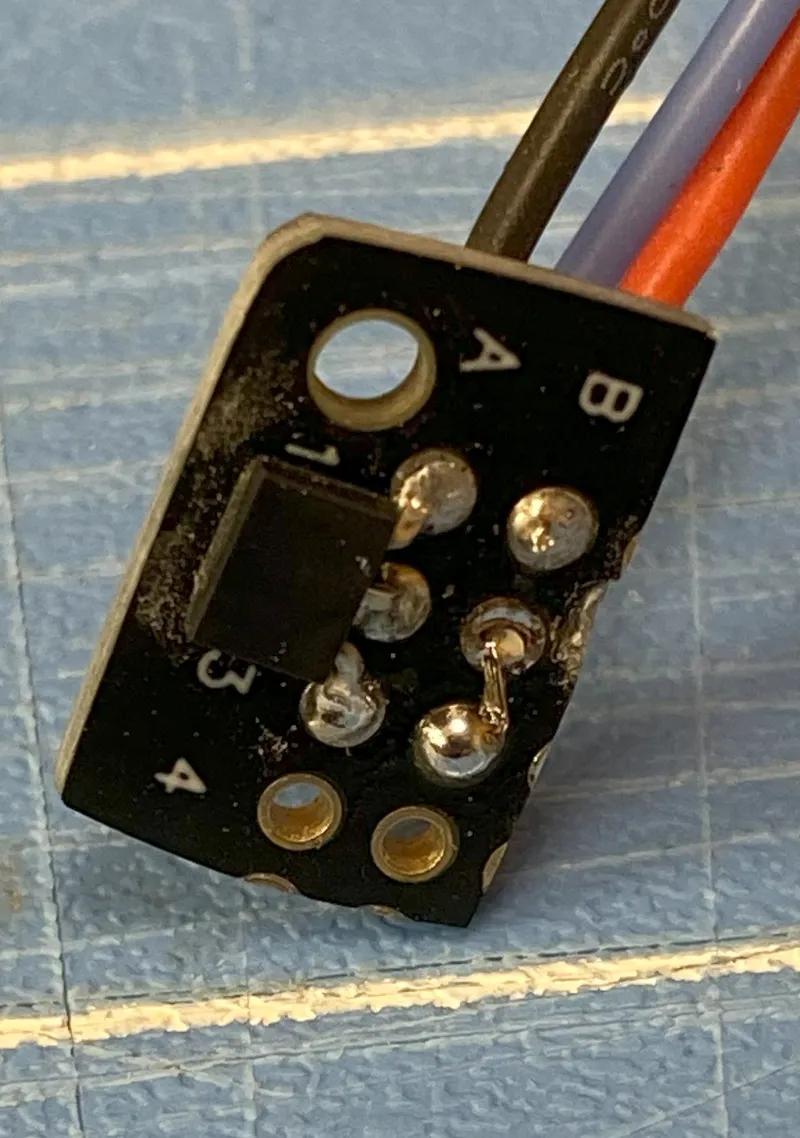
The Hall Effect Transistor was installed on a small breadboard PCB cut from a larger commercially available PCB. See BOM. This allows the wiring to be soldered to the PCB rather than the legs of the transistor. Proper transistor location is insured when the PCB is inserted into slots in the modified Base. See installation procedure.
Bucket Sizing
The length of the Blobifier Bucket is the same as the original design. The width was increased to a dimension equal to the distance between the Base and the opposing bed extrusion less 1mm. This forces the Bucket to be next to the base when properly installed. This results in a much larger Bucket compared to the original. Capacity has been demonstrated to be greater than 400 Blobs if shaken every 20 filament changes.
JST-XH Mount
The 4 position JST-XH connector was mounted on a small PCB which was in turn inserted into slots provided in the modified Base. The advantages of mounting the JST-XH connector are:
- Connector is designed to be PCB mounted not direct wired to pin connection,
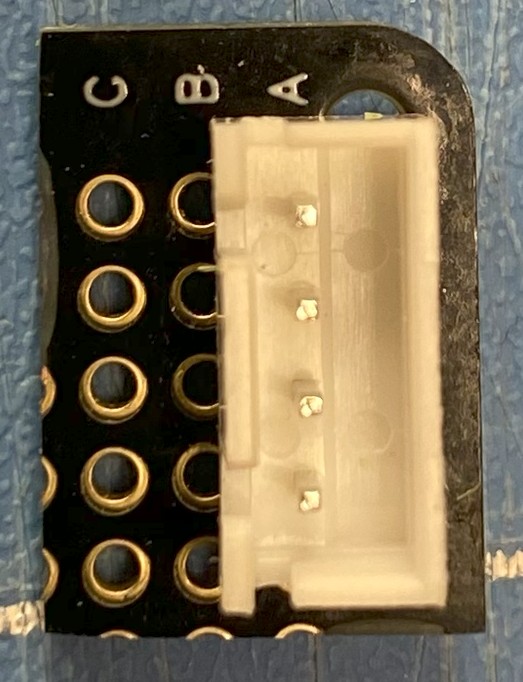
- Soldering wires directly to the pins on the connector can distort the pin geometry, making mating connector insertion difficult,
- Pins not firmly soldered onto a PCB are subject to being pushed out of the connector body when a mating connector is attempted to be inserted.
- PCB mount provides robust connector retainage throughout many insertion cycles. Mounting position is no longer reliant on small flange printed in the Base,
- The JST-XH PCB has several interconnected plated through holes allowing both the Servo and A3144 wires to be soldered to unique dedicated holes rather than direct solder to connector pins.
Other Modifications
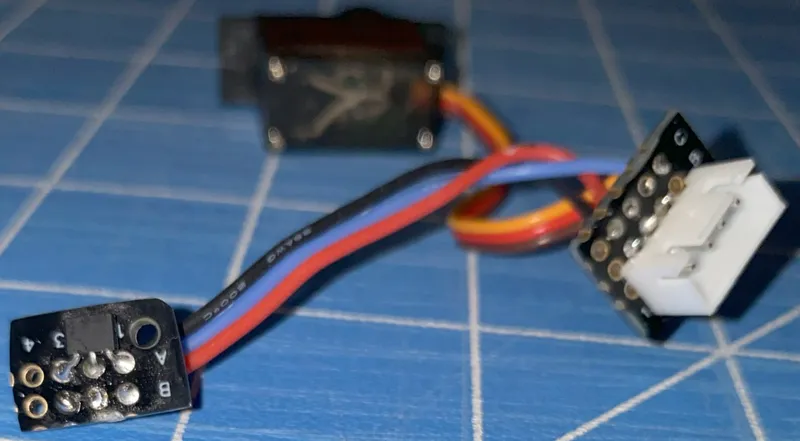
The Base was hollowed out to provide space for wire routing/storage.
This was possible by incorporating the mount into the base. Hollowing out the base allows the Servo, A3144 Transistor PCB, and the JST-XH PCB to be prewired prior to mounting in the Base. This simplifies the soldering and provides for easy installation.
An existing Brush and Waist Bucket was retained from previous modifications. The Brush Bucket was modified to fit flush with the back, center of the print bed. This captures the small amount of filament that is brushed off during nozzle cleaning. It also allows filament fragments that fall on the bed to be brushed directly into the Brush Bucket. Three (3) large magnets are press fit into each of the Brush Holder and the Brush Bucket to ensure that the Bucket is firmly held in place between cleanings. The STL files are included for these items.
BOW
| QTY | P/N | Description | Source |
| 1 | JST-XH | Connector | https://www.amazon.com/gp/product/B0B2R99X99 |
| 1 | A3144 | Hall Effect Transistor | https://www.amazon.com/gp/product/B09PG3PGH6 |
| 2 | M3x8 | SHCS Screws | https://www.amazon.com/Socket-Screws-Bolts-Thread-100pcs/dp/B07CMRQ3TB |
| 4 | M3x8 | FHSC Screws | https://www.amazon.com/DYWISHKEY-Stainless-Countersunk-Assortment-Wrenches/dp/B08QD86364 |
| 2 | M3 | T Nuts | https://www.amazon.com/Hulless-Sliding-Fastener-Aluminum-Accessories/dp/B08NZMD2BJ |
| 1 | 3x2mm | Magnet | https://www.amazon.com/gp/product/B09SLFSRBP |
| 1 | MG-90S | Servo | https://www.amazon.com/dp/B07L6FZVT1 |
| 3 | M2x6 | SHCS Screws | https://www.amazon.com/gp/product/B07FLLGW19 |
| 1 | M2x6 | FHCS Screw | https://www.amazon.com/DYWISHKEY-Stainless-Countersunk-Assortment-Wrenches/dp/B08QD86364 |
| 1 | Brush | Brass | https://www.amazon.com/gp/product/B091J3T11Q |
| 4 | M3 | Heatsets | https://www.amazon.com/gp/product/B09MCWTBCC |
| 1 | PCB | https://www.amazon.com/dp/B09WZXHMDG | |
| 6 | 10x2 | Magnets | https://www.amazon.com/gp/product/B092MB697H |


